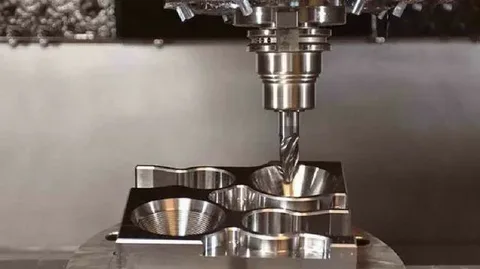In today’s manufacturing landscape, small businesses face increasing pressure to reduce production costs without compromising quality. CNC machining, known for its precision and efficiency, plays a vital role in achieving this goal. However, the high cost of equipment, setup, and maintenance often presents significant challenges for small-scale operators. That’s why applying cost-effective strategies to optimize CNC machining processes is crucial for boosting profitability and maintaining competitiveness.
For small businesses, understanding how to minimize expenses while leveraging the power of CNC machining can mean the difference between growth and stagnation. Whether you're producing custom components or handling short production runs, smart planning, and efficient workflows can significantly cut down on wasted time and resources. In this article, we’ll explore practical, actionable tips that can help small businesses maximize the return on investment from CNC machining operations.
Invest in the Right CNC Machining Equipment
Choosing the appropriate CNC machine for your specific production needs is the first step toward achieving cost-effectiveness. Many small businesses make the mistake of purchasing machines that are either over-specified or underpowered for their operations. While high-end models may offer a variety of features, you may not need all of them—especially if your production volume or part complexity is moderate. Instead, assess your specific requirements and opt for equipment that offers the right balance of functionality, scalability, and affordability.
Used or refurbished CNC machines can also be an excellent investment for small businesses on a tight budget. Reputable dealers often provide certified, pre-owned machines that perform just as well as new ones at a fraction of the cost. Moreover, buying the right machine reduces the risk of overconsumption of energy and raw materials, allowing businesses to optimize both operational costs and environmental sustainability. Always research thoroughly and consult industry experts before making significant capital investments in CNC machining equipment.
Optimize Design for Machinability
One of the most overlooked ways to reduce CNC machining costs is by designing parts with manufacturability in mind. Complex geometries, tight tolerances, and intricate detailing may look impressive but can increase machining time, waste, and tooling costs. Simplifying designs can drastically cut down production time, leading to lower labor and machine operating expenses. Whenever possible, use standard features, reduce the number of operations required, and avoid deep pockets or unnecessary undercuts.
Collaboration between designers and machinists is essential in this regard. When engineers understand how a CNC machine interprets and executes commands, they can design parts that are not only functional but also efficient to produce. Design for Machining (DFM) principles, such as minimizing setup changes and choosing cost-effective materials, play a major role in reducing expenses. Small businesses that integrate design optimization into their workflow often enjoy shorter lead times and increased machine uptime, resulting in substantial cost savings.
Reduce Tooling and Setup Time
Tooling and setup are major cost contributors in CNC machining, particularly for small batch sizes. Reducing the time it takes to change tools, load materials, or configure the machine for a new job can significantly lower overhead. One effective strategy is to standardize tooling across different jobs. By using tools that can handle multiple operations or materials, businesses reduce the need for frequent tool changes and minimize human error during setup.
Another approach is to invest in modular fixturing and quick-change workholding systems. These systems allow for faster setup and improved consistency, especially when switching between parts or projects. Additionally, using simulation software to test tool paths and setup configurations in a virtual environment can prevent costly errors on the shop floor. These strategies collectively ensure smoother operations and maximize machine utilization—key factors in making CNC machining more cost-effective for small businesses.
Maintain Your CNC Machines Properly
Preventative maintenance is crucial to extending the life of CNC machines and avoiding expensive downtime. Small businesses, in particular, cannot afford production halts due to machine failures. Regularly scheduled inspections and maintenance tasks—such as lubricating components, checking alignment, and replacing worn parts—can prevent unexpected breakdowns and improve machining accuracy. Maintenance logs and software can help keep track of servicing schedules and alert operators to potential issues.
Additionally, training your staff to recognize early warning signs of wear and tear can save money in the long run. Simple actions like cleaning chips from the machine bed, ensuring coolant levels are adequate, and monitoring spindle health contribute to smoother operations. An efficient maintenance program not only protects your investment in CNC machining equipment but also enhances product quality and customer satisfaction. Ultimately, a well-maintained machine produces consistent results and lowers the risk of costly repairs or part defects.
Take Advantage of CNC Machining Software and Automation
Modern CNC machining software can streamline operations and help small businesses reduce costs through automation and precision. Computer-Aided Manufacturing (CAM) software enables operators to create efficient tool paths, reduce material waste, and anticipate machining issues before they occur. By automating repetitive tasks and optimizing cutting sequences, software tools reduce programming time and improve overall productivity. This leads to faster turnaround times and lower labor costs.
Furthermore, integrating automation into your CNC machining process—such as using robotic arms for part loading or automated inspection tools—can dramatically increase efficiency, especially in low-volume, high-mix environments. While the initial investment in automation might seem steep, the long-term gains in productivity, consistency, and reduced human error often outweigh the costs. Small businesses that embrace software and automation not only improve their bottom line but also position themselves for future growth in a competitive manufacturing landscape.
Conclusion
Cost-effective CNC machining is not about cutting corners—it’s about making smarter choices. For small businesses, the combination of well-chosen equipment, efficient design practices, streamlined setups, consistent maintenance, and the strategic use of software and automation can transform CNC machining from a cost center into a competitive advantage. These strategies don’t require massive budgets but do require informed decision-making and a commitment to continuous improvement.



